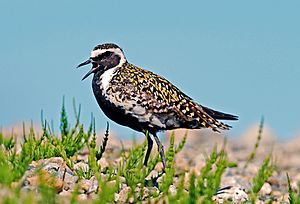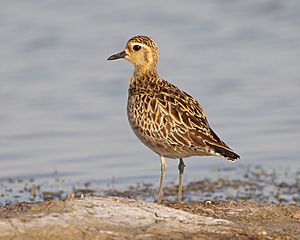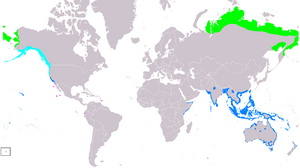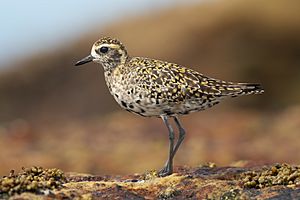Pacific golden plover facts for kids
Quick facts for kids Pacific golden plover |
|
|---|---|
 |
|
| In breeding plumage at Bering Land Bridge National Preserve, Alaska | |
 |
|
| In non-breeding plumage at Laem Pak Bia, Thailand | |
| Conservation status | |
| Scientific classification | |
| Genus: |
Pluvialis
|
| Species: |
fulva
|
 |
|
| Range of P. fulva Breeding Passage Non-breeding Vagrant (seasonality uncertain) | |
| Synonyms | |
|
Charadrius fulvus |
|
The Pacific golden plover (Pluvialis fulva), or Pacific golden-plover is a medium-sized plover. The genus name is Latin and means relating to rain, from pluvia, "rain". It was believed that golden plovers flocked when rain was imminent. The species name fulva is Latin and refers to a tawny colour.
The 23–26 cm long breeding adult is spotted gold and black on the crown, and back on the wings. Its face and neck are black with a white border, and it has a black breast and a dark rump. The legs are black. In winter, the black is lost and the plover then has a yellowish face and breast, and white underparts.
It is similar to two other golden plovers: the Eurasian and American plovers. The Pacific golden plover is smaller, slimmer and relatively longer-legged than the European golden plover, Pluvialis apricaria, which also has white axillary (armpit) feathers. Overall, the Pacific golden plover is found to be more similar to the American golden plover, Pluvialis dominica, with which it was once considered conspecific as "lesser golden plover". The Pacific golden plover is slimmer than the American species, has a shorter primary projection, longer legs, and is usually found to have more yellow on the back.
This wader forages for food on tundra, fields, beaches and tidal flats, usually by sight. It eats insects and crustaceans and some berries.
The breeding habitat of Pacific golden plover is the Arctic tundra from northernmost Eurosiberia into western Alaska. It nests on the ground in a dry open area.
It is migratory and winters in south Asia and Australasia. A few winter in California and Hawaii, USA. In Hawaii, the bird is known as the kōlea, and in New Zealand it is known to Māori as kuriri. It is very rare vagrant to western Europe. They return to the same wintering territory each year, which allowed scientists in Hawaii to attach tiny light level geolocator devices to the birds and then retrieve them the following year in the same location. This research revealed that these birds make the 4800 km non-stop flight between Alaska and Hawaii in 3–4 days.
- Pluvialis fulva in Field Guide: Birds of the World on Flickr
See also
 In Spanish: Chorlito dorado asiático para niños
In Spanish: Chorlito dorado asiático para niños




